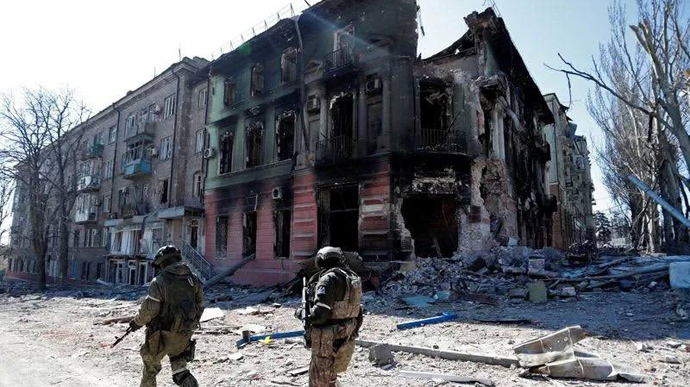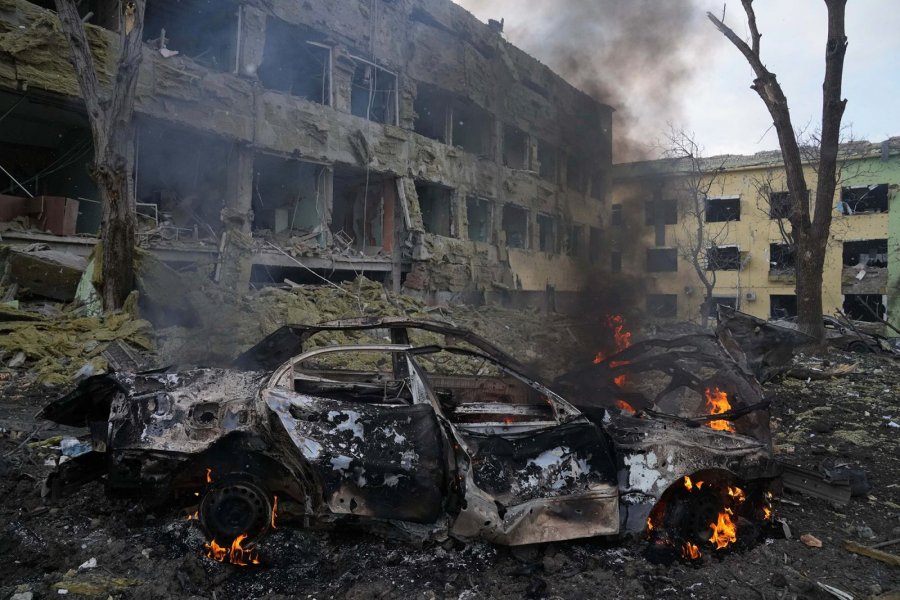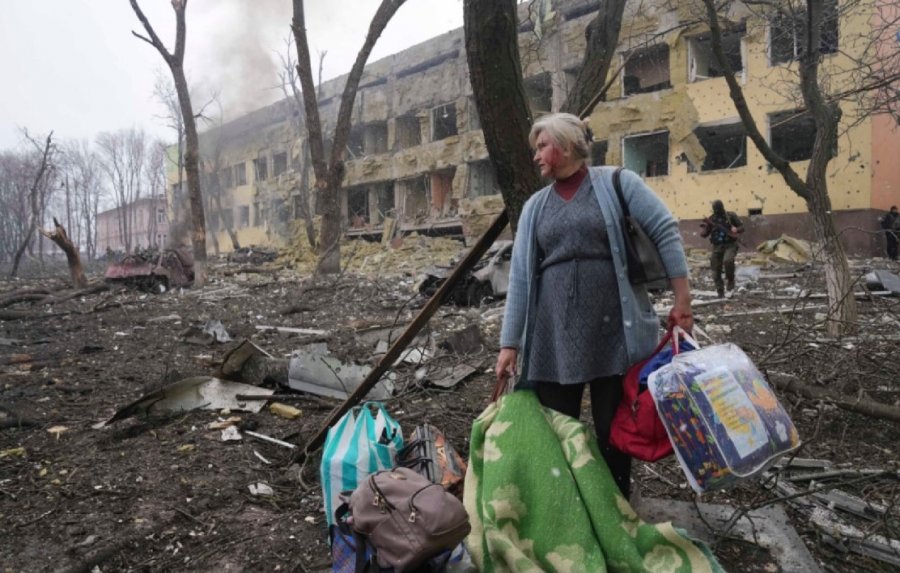Genocide in Ukraine. The example of Mariupol

The group targeted by the invaders in the Donetsk Region’s second largest city are that part of the Ukrainian nation resisting the aggressor. Beyond any doubt the group requiring protection is significant both in size and in its qualitative aspect: it embraces the various elites within the Ukrainian State and the vast majority of the country’s citizens. Today most Ukrainians are divided between those fighting against the occupying forces and others who, in every way possible, are aiding and supporting Ukraine’s fighters in that conflict.
The protected group
According to the 1948 Convention on Genocide —
the determining element of the crime of genocide is the deliberate intent to destroy members of a certain group (the Convention lists five types of genocidal act).
The goal of the Russian Federation in its war against Ukraine is to destroy the Ukrainian State and those inhabitants of the country who regard themselves as Ukrainians and are not prepared to submit to the Aggressor State. This goal constitutes the genocidal intent of the aggressor, which has been implemented differently in various parts of Ukraine — the city of Mariupol, and the Kyiv and Kharkiv Regions. Therefore, it is necessary, in our view, to examine the practice of genocide separately, taking account of its distinctive features, in each part of Ukraine.
This article considers the genocidal acts perpetrated against the city of Mariupol. In the terms of the Convention, the “protected group” in this case is made up of citizens of Ukraine living in Mariupol, some 450,000 individuals. It is our view that four of the five acts of genocide specified in Article 2 of the Convention (and included as Article 6 in the 1998 Rome Statute of the International Criminal Court) have been perpetrated in the city by Russia’s invading forces.
1. Killing group members
Mariupol was under siege from 26 February onwards, and from the first day of the war the city was constantly bombed and shelled by enemy aircraft and artillery. Thousands of its inhabitants died.
Numerous residential buildings, a children's hospital and a maternity hospital where pregnant women and babies were present, as well as buildings where civilians were hiding (the city theatre, a swimming pool, dormitories and an art school) were bombed and shelled by Russian troops and aviation.

According to information from various official Ukrainian sources there have been 87,000 civilian deaths in the city since 26 February.[1] The full extent of the killings in Mariupol will not be known until the city is liberated.
2. Causing serious bodily or mental harm
Russian troops systematically and directly attacked residential buildings, shelters and escape routes in Mariupol, causing the deaths of civilians. During the shelling of the city a substantial number of people were seriously injured. This was recorded by doctors who remained in the city and worked during the period of active hostilities.[2] There were no medical supplies and many people died in Mariupol from injuries and chronic diseases.[3]

After 26 February 2022, residents could not leave the city. Constant air strikes and the shelling of residential buildings forced people to live in basements unsuitable for human habitation. There they endured freezing temperatures. There was no access to food, water or medicines. People were in a state of constant fear and perceived their situation as a living “hell”.[4]
3. Conditions calculated to bring about physical destruction
The wording of this definition accurately describes the situation that developed in and around Mariupol after 1 March 2022.
3.1 Life in Mariupol
Early in March 2022, Russia’s armed forces destroyed Mariupol’s critical infrastructure (water, gas and electricity supplies, heating and communications). Then medical facilities were deliberately targeted and destroyed on the pretext that Ukrainian soldiers were posted or billeted there. Humanitarian and evacuation corridors were blocked. It was impossible to deliver water, food, medicine and children's necessities to the city.
Mariupol residents were forced to collect rainwater and boil technical water to drink; they cooked food on street fires. The complete encirclement of Mariupol, the lack of access to food, water, and medicine, and the destruction of the city's critical infrastructure led to a significant deterioration in the health of city residents and in some cases resulted in death.
Russia’s armed forces also controlled the airspace over Mariupol, so it was impossible to defend the city’s residential buildings, communal and socio-cultural institutions or its businesses and factories. In just a few weeks, the systematic shelling of residential areas by Russia’s armed forces destroyed more than 80% of the city’s housing.[5] Mariupol became uninhabitable and normal life was rendered impossible in the near future.[6]
3.2 Evacuation from the City
During evacuation from the city, residents of Mariupol were forced to undergo a humiliating filtration procedure.
Those who did not pass the first stage of filtration were taken into custody and sent to filtration camps for 30 days. There they were kept in terrible conditions, which in themselves can be classified as torture. They were denied access to basic necessities, including toilets, and suffered constant abuse and beatings.
Those who did not pass the second stage of filtration disappeared without trace.
*
These actions were all aimed at the creation of appalling conditions of existence, while those whom the occupying authorities considered enemies of Russia were imprisoned or disappeared. They were indeed “conditions calculated to bring about physical destruction”.
4. Forcibly transferring children to another group
Information from sources in Russia and testimony by Mariupol residents confirm that children have been transferred to Donetsk and to cities in the Russian Federation.
Children, who lost their parents during the hostilities, were taken to hospitals in Donetsk. Their relatives had to search all the institutions of the “Donetsk People’s Republic”, as well as Russian humanitarian agencies based in Mariupol, before the children could again be located.
The organised removal of children from Mariupol for adoption was supported by Putin's 30 May decree[7] simplifying the procedure for adopting children who arrived in Russia from Ukraine and his 11 July decree[8] which facilitated the easy acquisition of Russian citizenship.
According to former Ukrainian ombudsperson Lyudmila Denisova, 2,161 orphans and children of parents deprived of their parental rights were transferred to Russian foster families earlier this year. She was speaking in early June.
*
About the authors
Yevgeny Zakharov is director of the Kharkiv Human Rights Protection Group (KHPG). Before the war Tatyana Samoderzhenkova headed the public reception office of the Ukrainian Helsinki Human Rights Union in Mariupol and today continues to head it in exile.
The full version of this article may be read in Ukrainian and English on the KHPG website.
Notes
[1] Oleg Kotov, ”Russia’s armed forces have killed about 87,000 people in Mariupol but this does not include unidentified bodies [lying in the city morgue]”, Socportal.info, 30 August 2022.
[2] Sergy (Gorobtsov), Archbishop of Mariupol and Donetsk, “This lad Dima is from Mariupol”, Facebook (in Ukrainian), 18 April 2022. “He did not leave the hospital for three days: the story of [Victor Lokutov from Dnipro] a traumatologist who saved the wounded from Kramatorsk and Mariupol”, Vchasno news agency (in Ukrainian), 18 August 2022.
[3] Kateryna Rodak, “A 27-year-old doctor [Andrei Serbin] tells how he saved his own life under shelling in Mariupol. His story is amazing”, Zaxid.net (in Ukrainian), 28 April 2022.
[4] “Eyewitness accounts by photojournalists Serhiy Vaganov and Iryna Gorbacheva from Donetsk”, Ukrainska Pravda (in Ukrainian), 22 March 2022.
[5] “80-90% of the city was destroyed, says deputy mayor of Mariupol”, Ukrainska Pravda, 17 March 2022.
[6] “Satellite images taken by MAXAR Technologies and shared by The Guardian [London]: Burnt houses and a destroyed mall are shown by Mariupol satellite photos and a drone video”, Ukrainska Pravda (in Ukrainian), 18 March 2022.
[7] “Putin signs a decree simplifying Russian citizenship procedure for orphans from Ukraine”, Ukrainska Pravda, 30 May 2022.
[8] 11 July decree No. 440 (text in Russian).